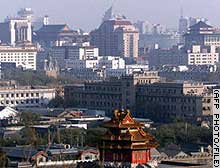I got a good look at the architecture of Beijing as I was flying into the city. As my friend actually decribed it, parts of the city look like Monopoly hotels. When someone builds an apartment complex in Beijing, they don't build one of them... they build 8 or 10 or 12 of them at a time. Unfortunately, they also build them exactly alike, so these apartment complexes will look exactly the same. Not to worry, because there will be another set of 8 or 10 or 12 apartment complexes will be built right beside them that will look different. The general theme here is that the majority of residential housing in Beijing is fairly plain.
 Fortunately the commerical buildings and government buildings look a bit more inspired. The commercial and shopping districts could easily be mistaken for that of a large North American city. It's very modern, and sometimes it's very painful to look at, as various architectural styles clash with each other in the Beijing skyline.
Fortunately the commerical buildings and government buildings look a bit more inspired. The commercial and shopping districts could easily be mistaken for that of a large North American city. It's very modern, and sometimes it's very painful to look at, as various architectural styles clash with each other in the Beijing skyline.China is modernizing itself, but this process is very uneven. As a result, traditional aspects and modern aspects are often beside each other. Uneven modernization will expand the rift between the lower class and the upper class. This class divide is obvious in China, with some people earning only 200 yuan per month, while others earn 2,000 yuan per month, while others earn 200,000 yuan per month. For the moment, people are willing to accept this for what it is... but as modernization continues, who's to say they will accept it in the future?


No comments:
Post a Comment